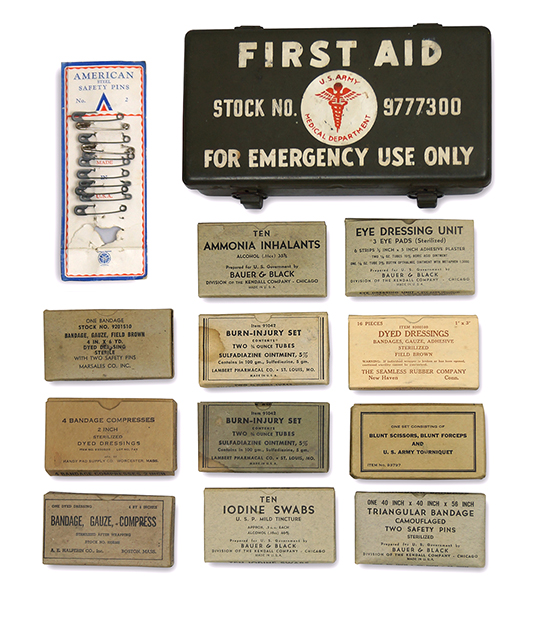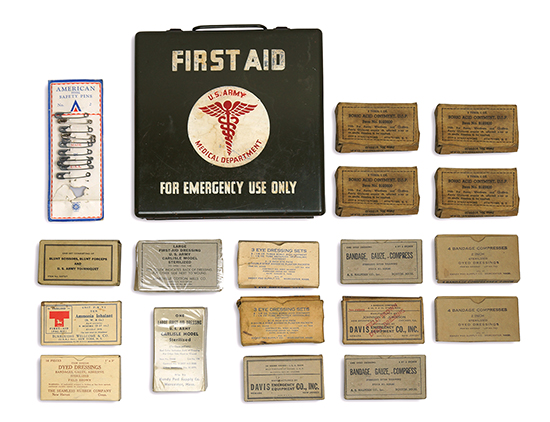Vehicle First-Aid Kits Medical Kits & Contents
In order to offer the best possible first response treatment in the event of a crash or injury involving the vehicle or its passengers, the United States Army Medical Department introduced a series of Motor Vehicle First-Aid Kits. These kits were specifically designed for certain vehicles, and this reflected in their contents. Each kit was divided into units, each of which was individually packaged within the metal container, and these included basic gauze dressings, tourniquets, scissors, along with drugs and medication such as Ammonia and Iodine.
This article looks at the various types of Motor Vehicle First-Aid Kits, along with their contents. Please click on the illustrations to enlarge.
Note: Morphine Tartrate Syrettes (½ grain) could be added to this kit upon the direction of the commanding officer when the military circumstances indicated its need.
The transportable metal container (Item # 9777400) was usually stashed away in a holding bracket, centrally located under the vehicle’s dashboard (1/4-Ton Truck, aka Jeep). This rectangular shaped container was provided with a single carrying handle and closed with 2 sets of two clips. Its cover held a paper contents list, glued underneath the lid, illustrating where each unit should be placed in the container, as well as some directions and recommendations related to First-Aid treatment. The complete Kit’s Item No. changed from 97773 (between mid-1943 and early 1944) to 9777300 (after 1 March 1944). It once again changed in 1947, following the standardization of both Army and Navy Stock Numbers, to Stock No. 9-221-200 (Army-Navy Catalog of Medical Materiel – 1 July 1947) and further kept the same number in 1949 (Armed Services Catalog of Medical Materiel, 1 July 1949). Stock No. 9-221-200 was gradually phased out during the 1950s, and replaced by First Aid Kit, General Purpose, 12 Unit, now identified as FSN 6545-922-1200 (FSN: Federal Stock Number).
The 12-Unit Kit’s contents did not undergo many changes during WW2. In spring of 1943, it still contained 6 sterile Individual Double Wrapped Envelopes of Sulfanilamide (5 grams) with Shaker Top, which disappeared early 1944. At the same time, the older 2 Burn Injury Sets were replaced by an improved version containing a more effective Ointment. Course of 1945, all former White bandage material was equally replaced by a less conspicuous Field Brown version.
Note: Morphine Tartrate Syrettes (½ grain) could be added to this kit upon the direction of the commanding officer when the military circumstances indicated its need.
The complete Kit was transported in a large metal container, closing with either 2 sets of two clips, or 1 set of two clips and a single narrow hinge. It had only one carrying handle. Once again, a brief instruction sheet and a list of contents were included underneath the container’s cover. Evolution of the Kit during WW2 brought about a change in Item Numbers, from its early war 97771, to its new 1 March 1944 number 9777100. After the July 1947 reorganization, the Kit became Item # 9-221-100.
An earlier version (1942-1943) did include 12 Sulfanilamide Shaker Top Envelopes (as the 12-Unit did), but these were deleted at the beginning of 1944. Also the 4 previous types of Burn Injury Sets were replaced (see 12-Unit Kit), while in 1945, the White bandages disappeared in favor of the Field Brown versions.
| 9776400 – Kit, First-Aid, Gas Casualty, Complete: | ||
|---|---|---|
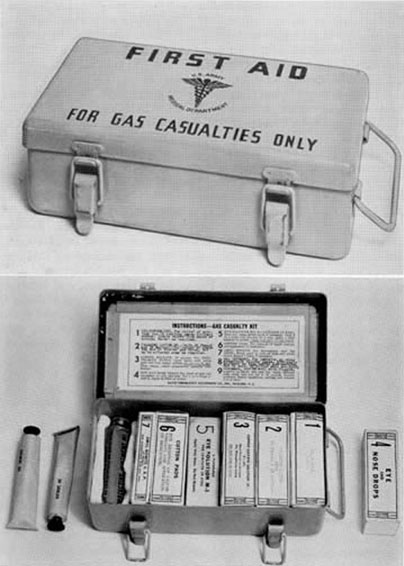 |
||
| Number | Item | Quantity |
| 9766300 | Container, for Kit, First-Aid, Gas Casualty | 1 |
| 1069000 | Amyl Nitrite, 10 Ampules | 1 |
| 9102800 | BAL Ointment, Two ¾-oz, Tubes | 1 |
| 9105000 | Calamine Lotion, approximately 2 oz | 1 |
| 9105800 | Chloroform, approximately 2 oz | 1 |
| 9107500 | Copper Sulfate Solution, approximately 2-oz Bottle | 1 |
| 9109100 | Eye and Nose Drops, ½ oz | 1 |
| 9109525 | Eye Solution, BAL, ½ oz | 1 |
| 9118700 | Protective Ointment, CWS, 3 oz | 1 |
| 9211800 | Pad, Cotton, approximately 1-Inch by 2-Inch, 50 | 1 |
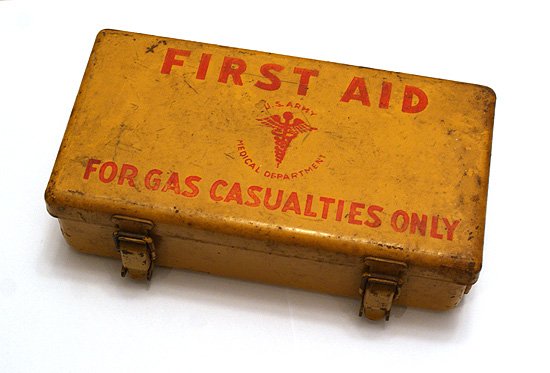
Illustration of first pattern of the Gas Casualty First-Aid Kit.
The Gas Casualty First-Aid Kit was issued in the Theater of Operations on the basis of one to each 25 individuals. It would usually be carried in motor vehicles, and was contained in a rectangular metal chest provided with a single carrying handle, almost identical to the 12-Unit Motor Vehicle Kit, except for its colors. The first or early pattern was painted yellow with red markings (some yellow versions existed with black markings), but a second pattern was introduced in the course of 1943, now painted olive-drab with black markings which proved less conspicuous. The Kit was again provided with an instruction sheet, indicating nomenclature, directions for use, and list of contents. Being of similar dimensions as the 12-Unit Kit, it could also be clipped into the bracket located under a jeep’s dashboard. Unlike the other Motor Vehicle Kits covered in this section, the Gas Casualty First Aid Kit underwent a great deal of modifications as the war progressed. For example up to 1943 , the Medical Department approved Item No. 9102800, BAL (British Anti-Lewisite) Ointment, for effective treatment of this contamination.
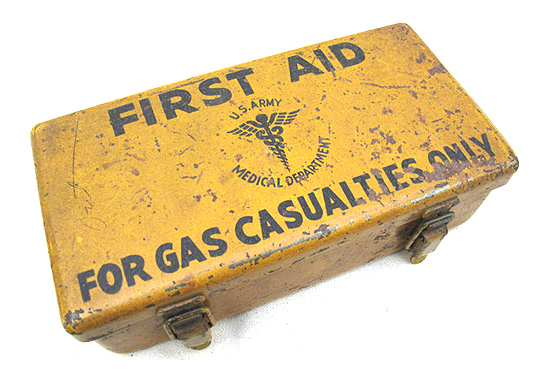
Illustration of a ‘tentative’ or ‘intermediate’ version of the Gas Casualty First-Aid Kit.
As the war in Europe battled on, it soon became apparent that cotton pads impregnated with Copper Sulfate Solution (Item No. 9107500) would be effective for the treatment of WP (White Phosphorous) burns on the skin, and in 1945 this was standardized in the form of an envelope containing 3 x dual-ply flannel pads impregnated with Copper Sulfate Solution, which was issued to every soldier. The only items which were deleted around mid 1944 were Dichloramine-T in Triacetin, the Hydrogen Peroxide Solution, and the Phosphorus Burn Set, reducing overall contents to 9 items, instead of 10.

Illustration of second pattern of the Gas Casualty First-Aid Kit.

